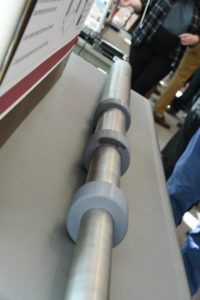A team of Washington State University Tri-Cities student mechanical engineers partnered with Washington River Protection Solutions (WRPS) to design a prototype instrument that could one day be implemented to assess the exact location, amount and arrangement of solid radioactive waste in Hanford tanks.
The device could solve a significant challenge at the Hanford site by providing engineers and scientists with a reliable, three-dimensional picture of the layout of solid waste. It would allow the researchers to better assess and prepare for future situations at the Hanford site as compared with currently used methods.
WRPS currently use devices that measure levels of solid waste at only one location in the tanks. They use either a sludge weight or other device that must sink down to the bottom of a tank’s liquid waste in order to determine the level of the solid waste. The current devices, however, only provide information about the levels of solid waste at one location in the tanks, the students said.
The student group, comprised of Bryan Chronister, Tanner Reyff, Rayce Barnes and Tomokazu Hager, designed a deploying system known as SLIM, or Solid Liquid Interface Monitor, for their senior design capstone project.
SLIM uses a sonar device to create an accurate picture of the levels of solid waste in a Hanford tank. It is resistant to radioactive contamination and decay and could be left in a tank as a long-term solution for creating a reliable picture of the placement of solid waste, Reyff said.
“It is submerged into the liquid level of the waste, and takes about five minutes to do a full scan of the tank with the sonar device,” Hager said. “Essentially, it creates a topographical scan of the full tank, which can be used for a range of future uses out at the Hanford site.”
Developing the design

The student group spent their first semester developing four different designs, which they later consolidated into one seamless design.
The team’s final design uses a winch to lower a telescoping tube into the liquid waste. The tubing is encapsulated in a chamber that protects the outside environment from radioactive contamination. The tube contains an existing sonar device that is also resistant to radioactive exposure. When the device is removed from a tank of waste, it has a high-impact spray system that washes the tubing, further reducing potential for contamination.
“We created a rigid design that provides control to the depth that is required and a stable insertion that would produce an accurate image of the solid waste within the tanks,” Reyff said. “The goal was to minimize the amount of radiation exposure.”
Supporting students to invest in the future
WRPS’ primary goal is to reduce the environmental risk posed by 56 million gallons of radioactive and chemical waste stored in 177 underground tanks at the Hanford Site that dates back to as early as World War II. The organization partners with WSU to develop technology that is specifically tailored to the needs of operating in one of the most radioactively contaminated environments in the world.
Kayle Boomer, manager of the Technology Management and Field Solution group with WRPS’ Chief Technology Office, said he is impressed with the student’s design and that is has potential for use at Hanford.
“The team worked well together,” Boomer said. “They were very diligent and tried to ensure that the design addressed as many design requirements as possible. The other Hanford engineers working with them thought they were developing a workable design for the tank farm.”
WRPS provided the student group, as well as one additional student engineering group, with a total of $10,000 to develop prototypes that could one day be applied at the Hanford site. The other student group, which is comprised of students Anthony Jenkins, Melissa Rivas, Oleg, Tyshchuk and Michelle Wheeler, developed a device to sample any interface within the Hanford tanks.
“It was a great experience working with the WSU senior engineering students on their senior design project,” said Jon Barnes, design services engineer for WRPS.
“Their energy and creativity were infectious. I’m hoping I’ll see them again in the engineering work world, and perhaps get a change to work together as peers.”
Jason Vitali, chief technology officer for WRPS, said the solutions identified by the students during their capstone project are extremely creative, thorough, and have the potential for resolving some of the challenges encountered in the high-hazard environment.
“It is important that the students continue to tackle real-world challenges during their education so they are able to transition after school and make contributions early in their professional careers,” he said.






